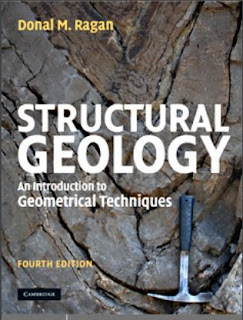Preface
The first steps in the study of geological structures are largely geometrical. This is true
in the historical development of our knowledge of such structures, in the initial stages of
any field investigation, and in the education of a structural geologist. This concern for
geometry includes the methods of describing and illustrating the form and orientation of
geological structures, and the solution of various dimensional aspects of these structures.
This book attempts to fill a need for an introduction to the geometrical techniques used
in structural geology. I have sought an approach which is basic yet modern. The topics
covered include well-established techniques, newer approaches which hold promise and
an introduction to certain fundamental mechanical concepts and methods. Students who
go no further in structural geology should have a working knowledge of the basic geometrical techniques and at least some appreciation of where the field is headed.
Those
who do go on, either in advanced courses or on their own should have the necessary
foundation.
The first few chapters apply the methods of orthographic projection to the solution
of simple structural problems. An introduction or review of these methods is given in
Appendix A. Application to geological and topographical maps are included and extensive
use is made of Mackin’s powerful method of visualization – the down-structure view of
geological maps.
The method of stereographic projection and the stereonet, together with the methods
of plotting and solving angular problems are introduced fairly early. Many of the same
elementary problems as well as some more advanced ones are solved with their uses.
Faults are described and classified. Problems of displacement are solved by combining
orthographic and stereographic methods.
The geometry of states of stress in two dimensions is then given in some detail. With this as background the Coulomb criterion of
shear failure is applied to the interpretation of shear and extensional fractures in rocks.
Folds are described and classified in a similar way. In particular, the orientation and
geometry are treated thoroughly. The powerful isogon classification of the shape of a single folded layer is treated in some detail. The relationship of these shapes to deformation
and strain is briefly outlined. Parallel and similar folds are the subject of separate chapters.
The subject has a mathematical side. It is a common observation that geology students,
despite having been exposed to these matters in other courses, do not retain much of
the material. As Vacher (1998, p. 292) put it, “Students leave that information in ‘that
other building’ when they go to their geology classes.” An important part of the problem
is that they do not have much opportunity, especially in introductory courses, to see
how mathematics can be applied to geology.
I have sought a variety of ways to address
this deficiency by including a number of applications throughout the book. Most of this
material has been placed in separate modules close to the areas to which they apply. Thus
an instructor or reader can use them, or not, but they can not be easily ignored. With
one exception, the mathematics will be recognized from introductory courses in physics
and calculus.
The exception is a brief introduction to matrix algebra, a powerful, natural
language of vectors and tensors.
Even at these early stages it is important to realize that geometry is not the end. The
final goal, however elusive, is a complete understanding of the processes responsible
for the structure in as great detail as possible. This is a branch of applied mechanics
(see Pollard & Fletcher, 2005).While an introductory course is not the place to treat
these matters in any great detail, it most certainly is the place to set the stage for such
a consideration. In particular, it is important to understand the core concepts of stress,
deformation, strain and flow.
Download Link




No comments:
Post a Comment